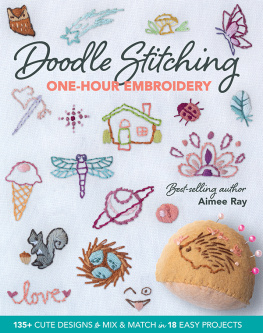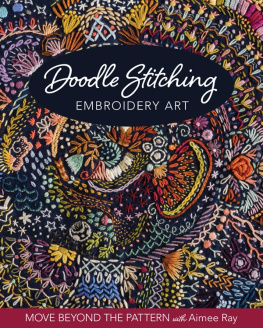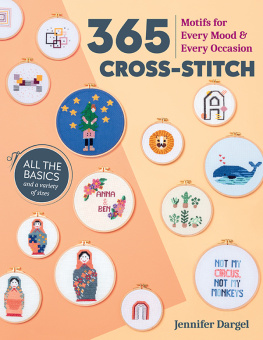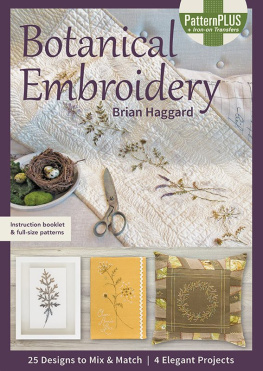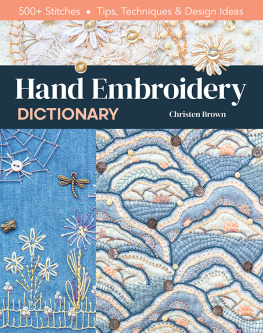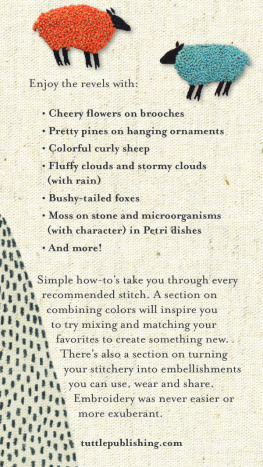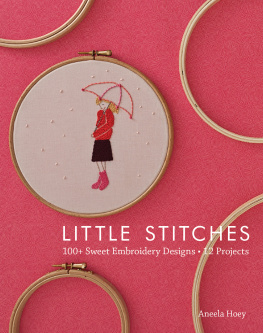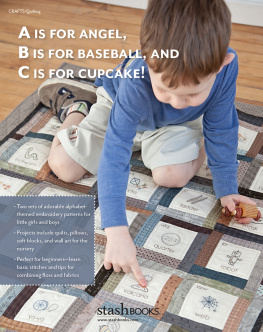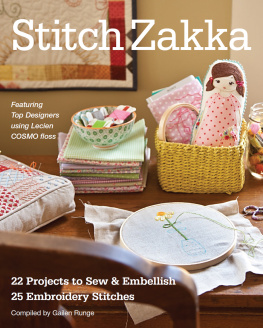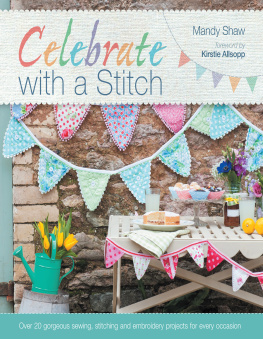
Publisher: AMY BARRETT-DAFFIN
Creative Director: GAILEN RUNGE
Acquisitions Editor: ROXANE CERDA
Managing Editor: LIZ ANELOSKI
Editor: KATHRYN PATTERSON
Technical Editor: DEBBIE RODGERS
Cover/Book Designer: APRIL MOSTEK
Production Coordinator: ZINNIA HEINZMANN
Production Editor: JENNIFER WARREN
Illustrator: AIMEE RAY
Photo Assistants: LAUREN HERBERG and GABRIEL MARTINEZ
Photography by ESTEFANY GONZALEZ of C&T Publishing, Inc., unless otherwise noted
Published by Stash Books, an imprint of C&T Publishing, Inc., P.O. Box 1456, Lafayette, CA 94549
Dedication
To everyone who thinks they dont have time to be crafty.

Acknowledgments
Sending many thank-yous to my editors and art directors at C&T for creating and producing this book, and to my friends, family, and online followers for always supporting and inspiring me.
HAND EMBROIDERY

Hand embroidery is one of the easiest, most inexpensive crafts there is. It is simple to learn with just a few basic lessons, very versatile, and calming and meditative as well. Though some embroidery projects can be extremely involved, taking weeks or months to complete, they certainly dont have to be! As youll see in this book, many small projects can be finished in just around an hour. If you have only a short amount of time in your busy lifestyle to pause and get crafty, or if you just love instant gratification, this book is for you. Youll be inspired and equipped to create all kinds of unique and fun projects with the patterns and instructions here. And trust meyou wont regret the time you put in! Making things with your hands is so grounding and rewarding that youll wonder why you didnt make time for it sooner.
Doodle stitching is my freestyle approach to embroidery, and it doesnt come with many rules. All you need is to learn a few basic stitches and techniques; then its up to you to choose the stitches and colors you want to use!
This book will show you the basic techniques and stitches that are simple enough for almost any age or skill level. In , youll find descriptions of all of the tools and materials youll be using, easy instructions for getting started with your stitching, and diagrams for lots of different embroidery stitches. Youll use many of the stitches for the projects, and Ive included a few extras so that you can experiment and discover your favorites.
The projects are simple, easy to put together, and all very customizable. In the back of the book youll find a library of additional motifs that you can use with almost any of the project ideas. Mix and match the designs to create something you love.
Have fun with these projects and patterns! I hope youll get inspired to bring more hand embroidery into your life, even if just for minutes at a time.
EMBROIDERY ESSENTIALS
Embroidery is one of the easiest crafts to learn and requires only a few simple tools that are readily available. Before you start embroidering, youll need to track down your supplies and learn several basic stitches and techniques.

MATERIALS AND TOOLS
You can start stitching with just fabric, floss, an embroidery needle, and a hoop, but you might find it useful to have a few additional items on hand. Plus, there will be certain tools youll need to complete several of the projects in this book. All the materials and tools are relatively inexpensive, and chances are good that you already have some of them on hand. If not, you can find them all at your local craft store.
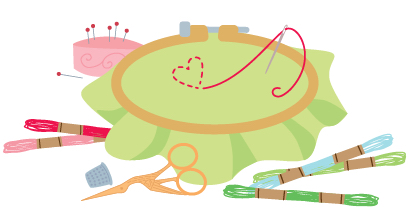
EMBROIDERY TOOLBOX
Embroidery and sewing needles
Embroidery floss
Embroidery hoop
Fabric stabilizer
Iron
Ironing board or towel
Needle threader (optional)
Nonpermanent fabric marker
Pencil
Pincushion
Ruler
Scissors
Straight pins
Thimble
Tracing and transferring tools
Tweezers
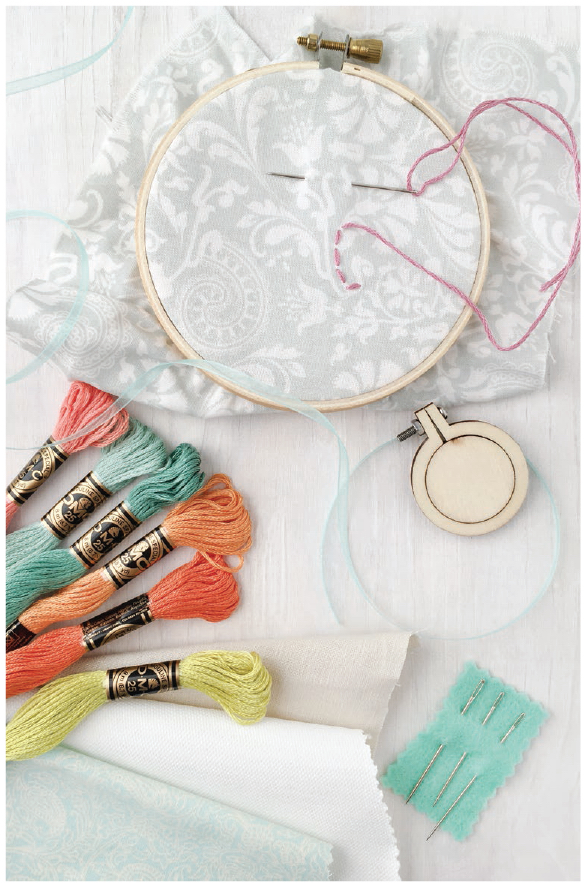
Photo by Aimee Ray
Fabrics and Other Materials
The most common fabrics used for embroidery are quilting cotton, linen made for handwork, and Aida cloth (a heavy fabric with a large, even weave); however, almost any fabric is suitable for embroidery. Heres my general rule: If you can stick a needle through it, you can embroider it. (That includes vinyl, heavy paper, balsa wood, and many other unconventional materials!) For the projects in this book, I mostly used quilting cotton or linen.
Delicate materials such as chiffon, silk, and sheer fabrics may require an extra bit of care when you secure them in a hoop so that you dont distort or stretch the weave. Fine fabrics and stretchy fabrics like T-shirt cotton usually behave better if you apply removable fabric stabilizer (see ) before you start stitching. Craft felt is a sturdy fabric that can easily handle hand stitching and generally wont pucker when embroidered. You may not always need a hoop when stitching on felt, especially if youre using small pieces. If youre just starting to embroider and need some fabric, take a look at your wardrobe or linen closet. You never know what inspiration you might find.
Floss
You can embroider with just about any thread, but the most common type used is embroidery floss. Floss is sold in a small bundle, or skein, and comes in any color you can imagine. Most floss is made from cotton, but if youre feeling adventurous, look for specialty flosses made of linen, metallic, silk, or wool strands to add a special touch to your stitching.

A length of floss is made up of six threads that are twisted together. You can use all six to stitch a thick line or divide them up and use a smaller number for thinner lines and fine details. Check the instructions for each project to see what number of threads is suggested. Typically, three threads is a good quantity. However, you may want to stitch small interior details with fewer threads and main outlines with more threads. Varying the number of threads on your project is one way to add dimension to your work.
Every skein of embroidery floss comes wrapped in paper with a different number for each color. Each floss manufacturer has its own unique numbering system for their colors. For each project in this book, youll find numbers for DMC embroidery floss.
Its easy to find conversion charts if you switch between brands. Check with specialty shops or search the internet for embroidery floss conversion chart. When youre starting a project, its a good idea to jot down the numbers youre using in case you need to get more floss later.
The more embroidery projects you make, the more floss youll accumulate. You might find it useful to organize the floss by wrapping each color on a plastic or cardboard bobbin. Write the color numbers on the bobbins and then store them together in a box. You can buy special sectioned containers at craft stores, but ordinary fishing tackle boxes also work great.
Next page
